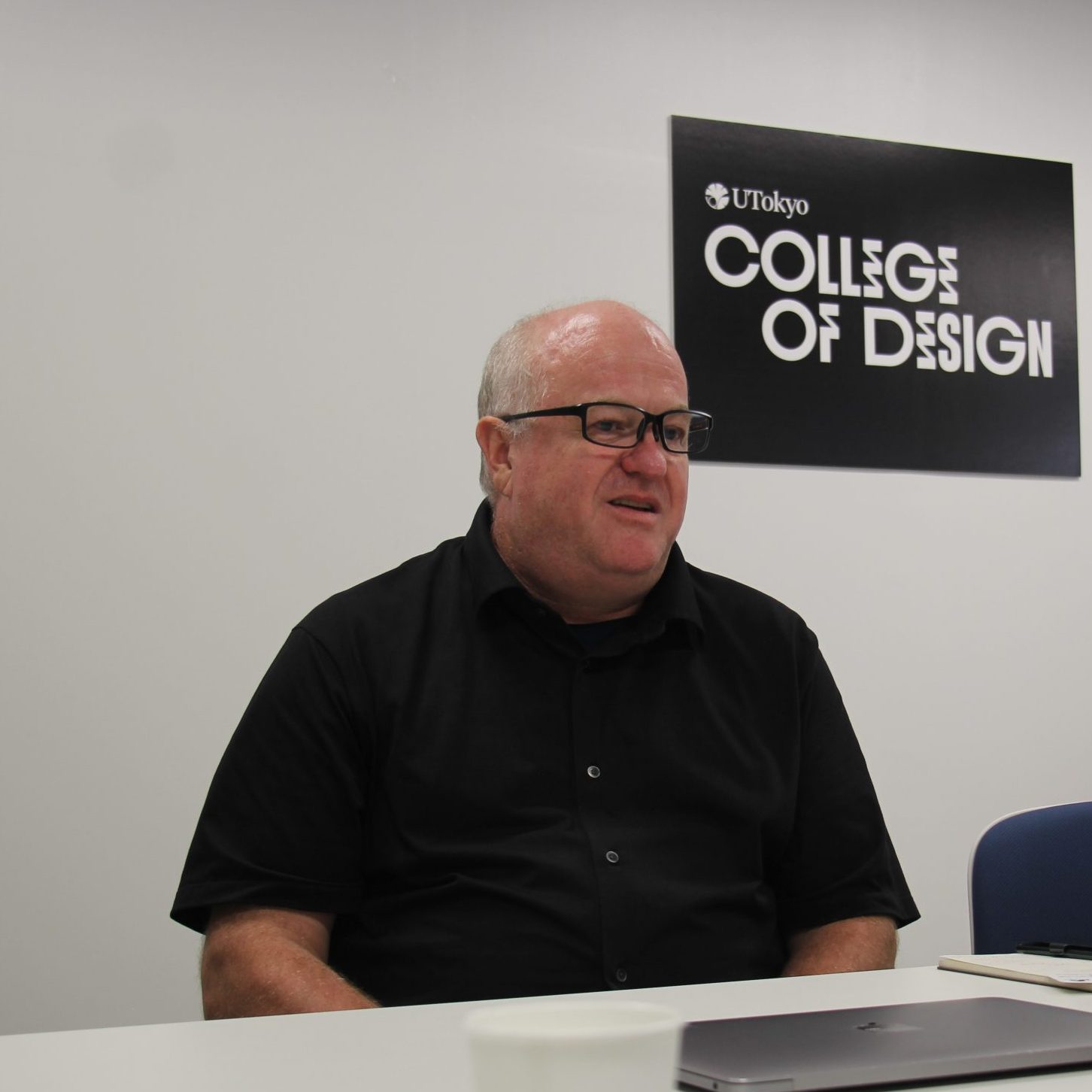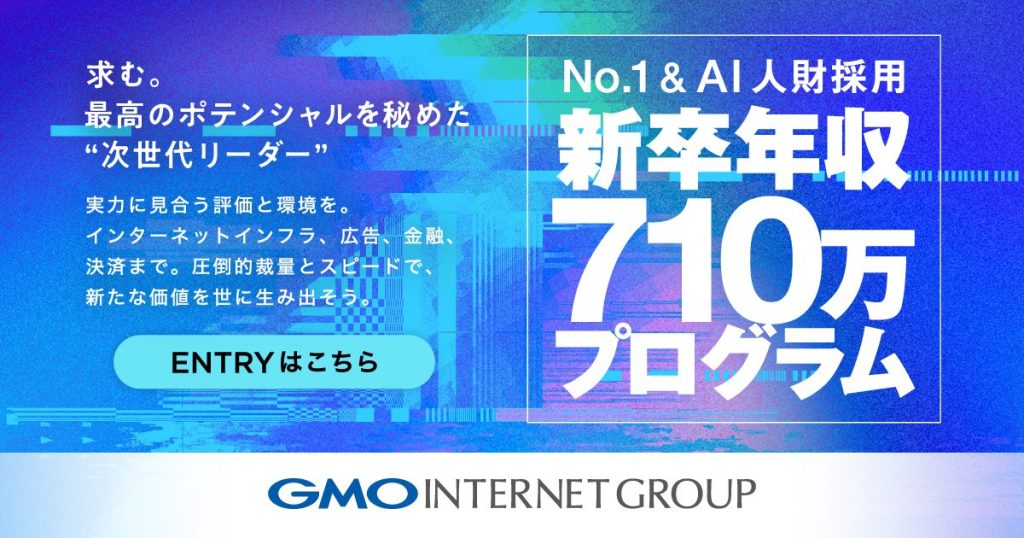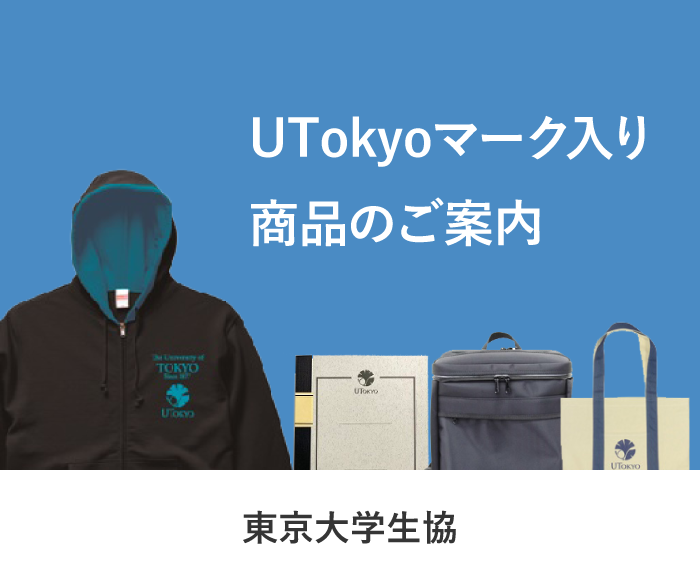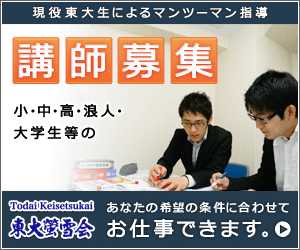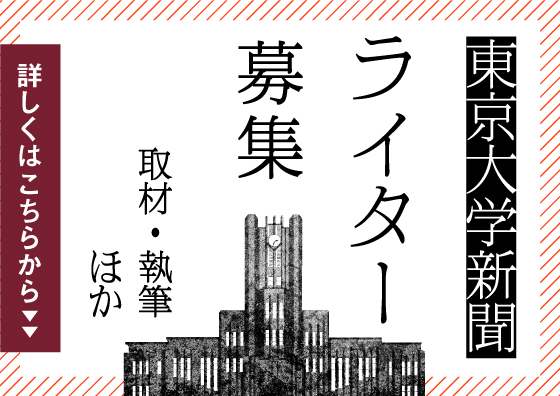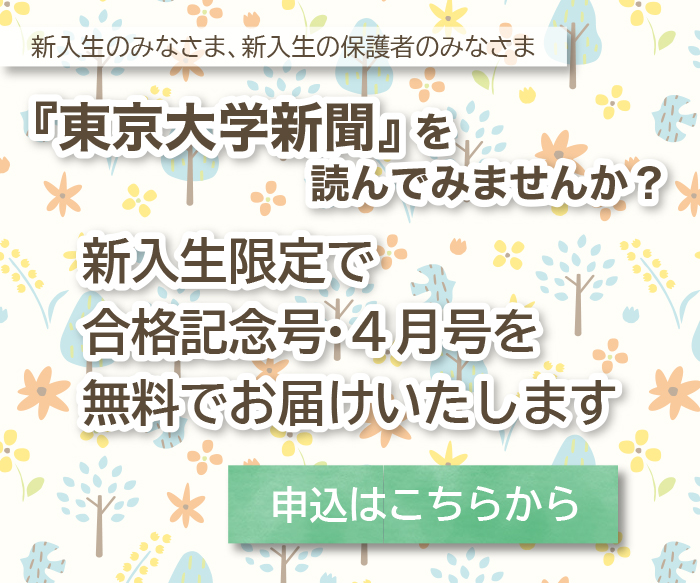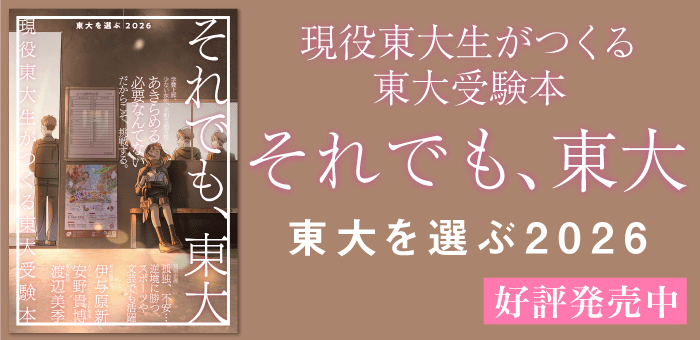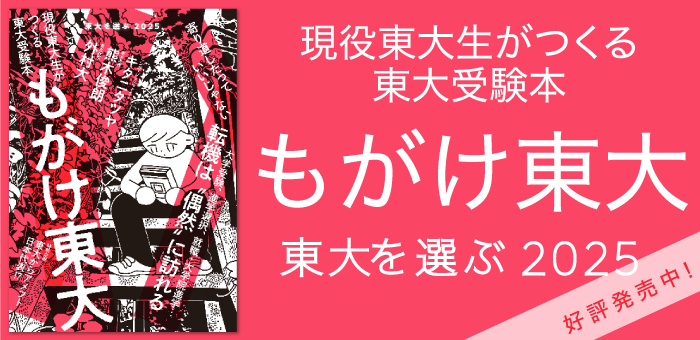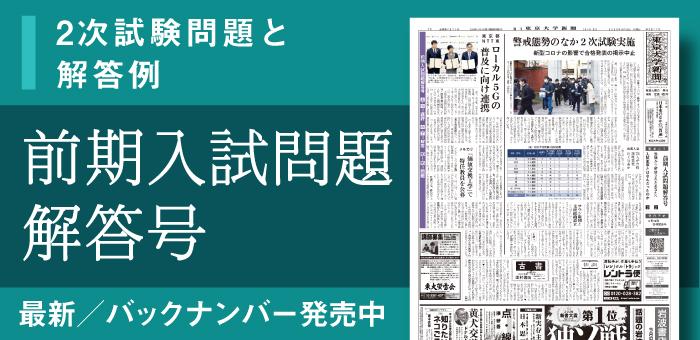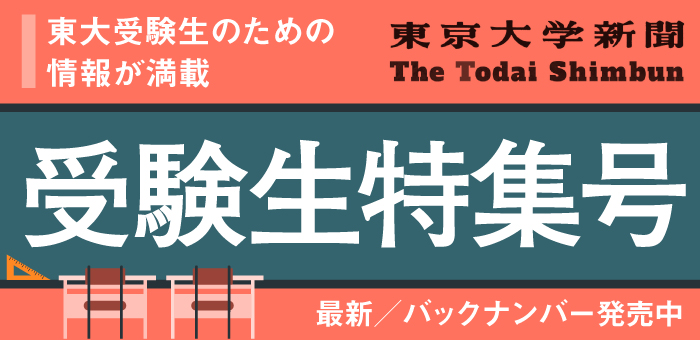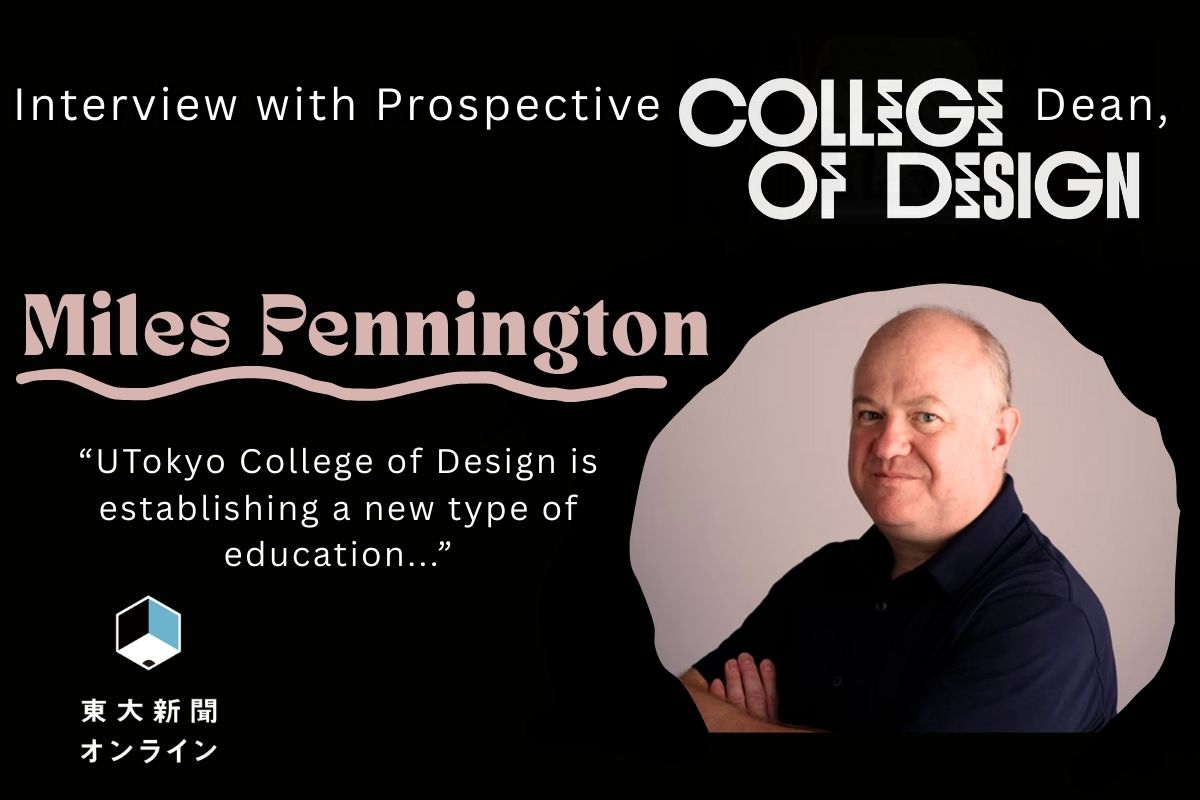
UTokyo is launching the College of Design in the fall of 2027, the first new faculty to be established at UTokyo in approximately 70 years. The College of Design will be an integrated bachelor and master’s program taught entirely in English, consisting of 100 students of diverse backgrounds. This is expected to play a central role in fulfilling government initiatives, such as the “University of International Research Excellence” (国際卓越研究大学) program, where UTokyo is currently applying for the second round. Although UTokyo was not selected in the first round in 2023, its proposal of the College of Design was highly praised by the Ministry of Education, Culture, Sports, Science and Technology’s expert panel. (Interview and text by Kamil Zeribi, photos by Takuto Oka)
What is the “College of Design”?
“Design”, defined on the College of Design website as“ the critical discipline that bridges knowledge and impact, turning insights into solutions”, is the guiding pillar of the program. This will be supported with a diverse range of interdisciplinary courses that incorporate the extensive range of specialized knowledge from existing UTokyo faculties. Students will begin their first year with fundamentals, such as “Interdisciplinary Foundations” and the “Eight Track Design Series” (Figure). Students will then build on that foundation, with seminars and elective modules beginning in their second year and carrying into their third year. This is also when students will begin design projects focused on social issues, titled “Change Maker Projects”. In their fourth year, an Off Campus Experience is built into the curriculum, with the possible options being an internship or exchange program. Finally, students in their fifth year and onwards will culminate their university experience with a capstone group and solo project, to be displayed in a graduation exhibition. Students in this integrated 4-year bachelor’s and 2-year master’s program have the option of graduating within 5 years, assuming exceptional grades.
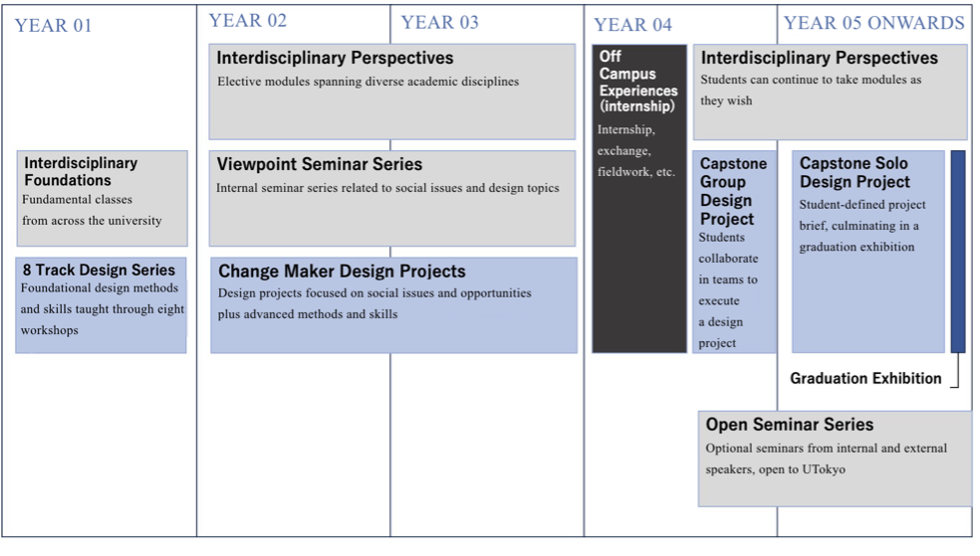
To accommodate incoming College of Design students, the UTokyo general selection will be reduced by 100 students, reducing the quota for each admissions category (such as Humanities I, Science II, etc.) by approximately three percent, starting with the 2027 entrance exam. College of Design students will have a separate entrance examination, tentatively named Route A and B, with a planned capacity of 50 students each.
Route A, whose focus is Japanese nationals, will require students to take the Japanese standardized university entrance examination, or Common Test (大学入試共通テスト). In addition, submissions of recommendations from teachers, English proficiency test results, and an essay written in English are required. While entrance interviews will be conducted in English, students are allowed to use Japanese if necessary.
Route B, whose focus is international students, will also require recommendations from teachers, an essay written in English, and an interview conducted in English (overseas applicants will not be required to travel to Japan for the interview). Applicants will also be required to take a standardized exam, such as International Baccalaureate, A-levels, SAT or ACT. Applicants may be required to submit English proficiency test results, depending on their English educational background.
Details of the English proficiency test, essays, and international standardized examination, the specific timing of interviews, and target scores for the common test are currently under consideration, and details will be announced by around August 2026.
The program will be based at the Hongo Campus, utilizing the former Information Infrastructure Center, which is scheduled for renovation. First-years will board in the UTokyo dorm, Mejirodai International Village, alongside other UTokyo undergraduate students, exchange students, researchers, and more.
The plan is currently being submitted to the Ministry of Education, Culture, Sports, Science and Technology (文部科学省), and may be subject to change. The College of Design will replace and build on the current UTokyo 4-year English-taught degree, Programs in English at Komaba (PEAK) Program, which was founded in 2014 and will stop receiving incoming students after fall of 2026.
“I do it because I absolutely want to see the College of Design vision delivered, as UTokyo President Fujii and I imagined it… …It’s an amazing, magical opportunity.” -Prospective Dean Miles Pennington
To learn more about the UTokyo College of Design (College of Design), The Toudai Shimbun interviewed Professor Miles Pennington (Interfaculty Initiative in Information Studies, UTokyo), who will lead the College of Design as Dean.

──How did the idea of the College of Design grow into a 5-year bachelor and master’s program?
We wanted to create a new type of graduate who can address social issues and make meaningful change to the world, and we thought five years of study would be necessary. UTokyo College of Design will offer five categories within the Interdisciplinary Perspectives – “Environment & Sustainability”, “Technology Frontiers and AI”, “Governance & Markets”, “Healthcare & Wellbeing”, and “Culture & Society” – that include a wide range of courses that students can choose from. Students don’t have to specialize in any one field. This is a fundamental point of the program. They are in a Design program, but it’s focused on social issues and challenges. They can do a project in climate change, the following in social justice, or the future of education. That said, it needs to be something where there’s an issue in society or a future opportunity that needs to be realized properly- not just to make another chair or table.
──The name “College of Design” could be interpreted as “design” in a more narrow or traditional sense, as in artistic design. How do you plan to communicate to companies and prospective students your intended meaning of design?
People often bring this up, as design – especially in Japan – is often seen solely as aesthetics or crafts, but it’s also an important and strategic discipline. I think we need to expand the global understanding of design as a powerful, strategic tool. It’s important that we establish a truer and more powerful meaning for the word “design”. I’m fully expecting to have this conversation, willingly, for the next few years, until graduates come out and people see their influence on the world… …it’s about people understanding the true value of design.
──Why was the College of Design decided to be a Design program?
Design is a powerful tool for enabling change- understanding challenges, for creating ideas, and then deploying those ideas into reality and testing them with people. That’s what design is all about. From the start, we didn’t want anyone to have to specialize in any particular field. For example, students can, from day one, do all their projects on the environment. The most important thing is it’s up to them. They’re making those choices. We’re going to have 100 courses that we have developed in collaboration with members from around the university that they can choose from, in a true liberal arts fashion. These courses cover wide disciplinary knowledge and will be the essential component of the program. That knowledge will then filter through into their creative work, which will start at their 2nd year with set thematic projects at first. In their 4th and 5th years, they will have more freedom, creating their own project teams and projects. It’s very much about the students’ selected pathway. We want students to end the course as independent, self-directed changemakers.
──How do you plan to attract the desired 100 prospective College of Design students?
UTokyo College of Design is establishing a new type of education, so we need to work hard to get out there and market ourselves with traditional communication methods. We started promotion events this July- so we’ve had two in-person and two online events already (as of July 25, 2025). Promoting ourselves, marketing ourselves, is really important. Our intention is to do that nationally – not just on-campus, not just Tokyo – but really reaching the far-regions of Japan, because it’s also a mission of ours to bring more diversity to UTokyo. Then on top of that, we have the mission of getting out and telling people in Europe, North America, South America, Africa, around Asia and so on, about the College of Design…for example, we had some visitors from Singapore, the UAE and others at our recent in-person event, who were quite excited about coming to Tokyo to study. Now, of course, we don’t have the budget of large global enterprises to do global advertising or anything, so we must be targeted, but our absolute mission is to bring these excellent, diverse people into UTokyo.
──You must be quite busy with the College of Design promotional events starting.
Yes, it’s kind of like a start-up environment. There was a newspaper headline stating, ‘First time in 70 years UTokyo has started a new undergraduate faculty,’ which is technically correct, but in 70 years the university has evolved in a large number of ways. However, this is the first time a new faculty has been created from scratch in approximately 70 years. So, it very much feels like a start-up, where every week we accelerate in a new direction. New discoveries, new activities, and new wins happen.
──You mentioned previously that 100 courses are planning to be taught at the College of Design. How do you plan to find educators that are not only proficient in English, but also add to the international nature of the program?
We want an international team, that is both Japanese and international, that can teach well, teach and work across disciplines. We need educators that can not only teach in English, but we also want classes to be taught in active or project-based learning. This means no traditional lectures or professors at the front, reading from a book. They must engage with learning through debates, discussion, and other group activities, which is an additional challenge. It is important that everyone is at a high level of communication ability. We’re looking for educators now and recently put a call out. We received an overwhelming response with 700 applications from all over the world and our LinkedIn post got 45,000 impressions so far and is still going.
──You clarified that the College of Design aims for a significant number of the 100 planned courses to be delivered by teachers from other UTokyo faculties. How do you intend to achieve this?
This is what we are working on now. We want to make sure that they feel the value of collaborating with the College of Design and teaching our students. We have received positive feedback from many faculty members from around the university. About the point of collaboration, we want to grow what we call the “Affiliates Program,” which is a way for the College of Design to integrate with the rest of the university, not just as a separate faculty, but by having connections across the university.
── Hongo Campus is separate from the Komaba Campus, where most first- and second-year students study. Why was Hongo chosen for the College of Design? How do you plan to promote interaction between students from both campuses?
Part of the reason we placed the college at Hongo Campus is to tap into the faculties around us for the interdisciplinary classes. This will provide opportunities for students to connect with wide disciplinary knowledge. We aim to facilitate interaction between students from diverse backgrounds across the university, including those at Komaba, and students of UTokyo College of Design. The “Affiliates Program” is one example of such opportunities.
──How are you planning to enrich student life at Hongo Campus?
The College of Design will have a studio atmosphere. The current plan is to have two studios- two big open rooms, where everyone has space to work. That becomes their campus home. It’s not like coming in for a couple of classes and then going home. You’re working with a team on a project, go to coffee or for lunch, come back to the studio and do more work. The studio will hopefully be an interesting, relaxing place to exchange ideas and get to know more people. Hopefully in the future, we can also encourage other UTokyo students to integrate into the College of Design. The goal is to build more bridges and have more ways of students and staff collaborating in the college. The studio life is the key difference point- having a home on campus.
──Within the 5-year curriculum, an “Off Campus Experience” is built in. How do you envision students benefitting and taking advantage of this opportunity?
The off-campus experience was one of the original visions from the UTokyo President. In Europe and the U.K., it’s relatively common to do, for example, study abroad or do a sandwich year with a company. I think it is one of the opportunities that is less taken up here, because of complications with credit transfer and job hunting. From day 1, the Off Campus Experience was set into the curriculum as mandatory. You don’t have to worry about job hunting or the credits, this will happen. We will start the program based on internships at the moment. In collaboration with companies, we will provide students with a learning experience that is going to have a meaningful impact on their future. We may also ask the companies to provide mentors to guide the students. The general idea is that we want international students to have a Japanese company experience, because that will be culturally different and more mind expanding, and vice versa. So Japanese students, who have grown up in Japan, will have international company experience. That’s the general idea at the moment.
──While College of Design is a program taught in English, living in Japan requires some Japanese proficiency. How do you plan to support these students in that regard?
That is currently our important question. We’re not putting Japanese classes directly into the curriculum. Partly, because currently, the curriculum is already intense with many learning opportunities. But we’re aware that life in Japan becomes a lot easier if you have Japanese language ability. There is however quite a bit of language support around the university. We are exploring different possibilities and opportunities. We will have an answer by 2027.
──UTokyo is applying for the “University of International Research Excellence Program” and has received criticism for low internationalization in global university rankings. Have these factors influenced the planning of the College of Design?
It probably has, it’s difficult to comment on university-wide policies above the college. My genuine feeling is since I’m coming from London, a diverse team is the best team you can have in a design program. We were very lucky in London, we had 100 students from 30, sometimes 40 different countries. And that was an incredible atmosphere for creativity. Different cultures bring different thinking. That’s what we want to create in the College of Design. While that’s also beneficial to the university’s international standing, you can’t look to one college to solve the whole university’s challenge. That’s got to be through a higher-level strategy. But our mission is to have that diversity. Not simply to solve the university’s challenge, but because difference brings difference. Your thinking will be different from someone else’s thinking, and if you’re all from the same culture, the same background, you tend to create the same ideas. Our mission is to create a lot of contrary thinking, argument, and debate. That will generate the best innovations.
──What are your own hopes for the College of Design, or is there anything you’d like to say that you haven’t had the opportunity to yet?
It’s rare to have the opportunity to plan and deliver an entirely new faculty. My whole life has been about crossing disciplines and breaking down the barriers of design, so it feels like the pinnacle of everything I’ve done. There is never a dull moment. 2027 sounds like a long way away, but it isn’t really, it’s going to come around quickly. It is frustrating. I just want to start, to get going, and make this happen. It has an amazing vision, and I want to see it delivered.
This interview was conducted in English and has been edited and condensed for clarity.
